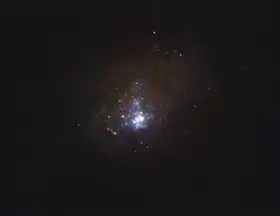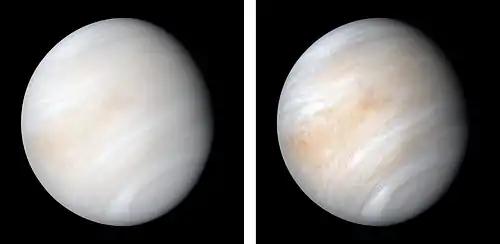PHL 293B
PHL 293B, also known as Kinman's dwarf, is a low-metallicity blue compact dwarf galaxy about 22.6 Mpc from the Earth in the constellation Aquarius.[3]
| PHL 293B | |
|---|---|
| Observation data | |
| Constellation | Aquarius |
| Distance (comoving) | 22.6 million parsec |
 Hubble Space Telescope image of PHL 293B; the purported luminous blue variable is located near the core of the galaxy Credit: NASA, ESA/Hubble, J. Andrews (U. Arizona) | |
| Observation data Epoch J1950 Equinox J1950 | |
|---|---|
| Constellation | Aquarius |
| Right ascension | 22h 28.1m [1] |
| Declination | −0° 22′[1] |
| Characteristics | |
| Evolutionary stage | Luminous blue variable? |
| Astrometry | |
| Radial velocity (Rv) | (of galaxy) 1,606[2] km/s |
| Distance | 22,600,000[3] pc |
| Details | |
| Radius | 1,348–1,463[4] R☉ |
| Luminosity | 2,500,000–3,500,000[4] L☉ |
| Temperature | 6,000–6,800[4] K |
| Other designations | |
| Database references | |
| SIMBAD | PHL 293B |
| PHL 293 (Simbad mistakenly showing results for PHL 293B) | |
It had a very likely associated, notable, blue-light, long-lived star with constant outbursts or a large supernova observed to have faded and which then disappeared. Although this bright visible jet-producing object responsible for broad hydrogen emission lines with P Cygni profiles was widely considered to be a luminous blue variable ejecting matter, other studies posited the mentioned, competing, explanations for the bright light source within.
Observation history
PHL 293 was first listed as entry 293 in a catalogue of faint blue stars published by Guillermo Haro and Willem Jacob Luyten in 1962.[7] In 1965, Thomas Kinman observed two faint possible companions to it, about 1′ away, which he dubbed A and B. HL 293B, sometimes called Kinman's Dwarf, was noted to be an extragalactic, nonstellar object, with a jet, approximately 22.6 Mpc away from Earth.[3][5] The acronym PHL has since been applied to distinguish it from other HL catalogues; it is most commonly referred to by astronomers as PHL 293B.[1] The galaxy was identified as a blue compact dwarf, a type of small irregular galaxy undergoing a strong burst of star formation.[6]
The spectrum of PHL 293B is unusual both for its low metallicity and for broad hydrogen emission lines with P Cygni profiles. These are interpreted as being from a large luminous blue variable star in the galaxy. The star is believed to have been undergoing an outburst during previous observations,[6] an interpretation is disputed by some publications. An alternative explanation would be a long-lived type IIn supernova, similar to the transient event of SDSS1133.[8] These emission features in the spectrum of the galaxy faded during 2019 and by the end of the year had disappeared (at least visibly), likely due to the disappearance of a bright star of the galaxy.[4]
See also
References
- French, H. B. (1980). "Galaxies with the spectra of giant H II regions". The Astrophysical Journal. 240: 41. Bibcode:1980ApJ...240...41F. doi:10.1086/158205.
- Guseva, N. G.; Papaderos, P.; Meyer, H. T.; Izotov, Y. I.; Fricke, K. J. (2009). "An investigation of the luminosity-metallicity relation for a large sample of low-metallicity emission-line galaxies". Astronomy & Astrophysics. 505 (1): 63–72. arXiv:0908.2539. Bibcode:2009A&A...505...63G. doi:10.1051/0004-6361/200912414. S2CID 17490296.
- Kinman, T. D. (1965). "The Nature of the Fainter Haro-Luyten Objects". The Astrophysical Journal. 142: 1241. Bibcode:1965ApJ...142.1241K. doi:10.1086/148392.
- Allan, Andrew P.; Groh, Jose H.; Mehner, Andrea; Smith, Nathan; Boian, Ioana; Farrell, Eoin J.; Andrews, Jennifer E. (2020). "The possible disappearance of a massive star in the low-metallicity galaxy PHL 293B". Monthly Notices of the Royal Astronomical Society. 496 (2): 1902. arXiv:2003.02242. Bibcode:2020MNRAS.496.1902A. doi:10.1093/mnras/staa1629. S2CID 220302328.
- Terlevich, Roberto; Terlevich, Elena; Bosch, Guillermo; Díaz, Ángeles; Hägele, Guillermo; Cardaci, Mónica; Firpo, Verónica (2014). "High-velocity blueshifted Fe ii absorption in the dwarf star-forming galaxy PHL 293B: Evidence for a wind driven supershell?". Monthly Notices of the Royal Astronomical Society. 445 (2): 1449–1461. arXiv:1409.1189. Bibcode:2014MNRAS.445.1449T. doi:10.1093/mnras/stu1806. S2CID 118457805.
- Izotov, Yuri I.; Thuan, Trinh X. (2009). "Luminous Blue Variable Stars in the two Extremely Metal-Deficient Blue Compact Dwarf Galaxies DDO 68 and PHL 293B". The Astrophysical Journal. 690 (2): 1797–1806. arXiv:0809.3077. Bibcode:2009ApJ...690.1797I. doi:10.1088/0004-637X/690/2/1797. S2CID 14150936.
- Haro, G.; Luyten, W. J. (1962). "Faint Blue Stars in the Region near the South Galactic Pole". Boletín de los Observatorios de Tonantzintla y Tacubaya. 3: 37. Bibcode:1962BOTT....3...37H.
- Burke, Colin J.; Baldassare, Vivienne F.; Liu, Xin; Foley, Ryan J.; Shen, Yue; Palmese, Antonella; Guo, Hengxiao; Herner, Kenneth; Abbott, Tim M. C.; Aguena, Michel; Allam, Sahar; Avila, Santiago; Bertin, Emmanuel; Brooks, David; Carnero Rosell, Aurelio; Carrasco Kind, Matias; Carretero, Jorge; Da Costa, Luiz N.; De Vicente, Juan; Desai, Shantanu; Doel, Peter; Eifler, Tim F.; Everett, Spencer; Frieman, Josh; García-Bellido, Juan; Gaztanaga, Enrique; Gruen, Daniel; Gruendl, Robert A.; Gschwend, Julia; et al. (2020). "The Curious Case of PHL 293B: A Long-lived Transient in a Metal-poor Blue Compact Dwarf Galaxy". The Astrophysical Journal. 894 (1): L5. arXiv:2002.12369. Bibcode:2020ApJ...894L...5B. doi:10.3847/2041-8213/ab88de. S2CID 211572824.


_on_Jul_14_2020_aligned_to_stars.jpg.webp)